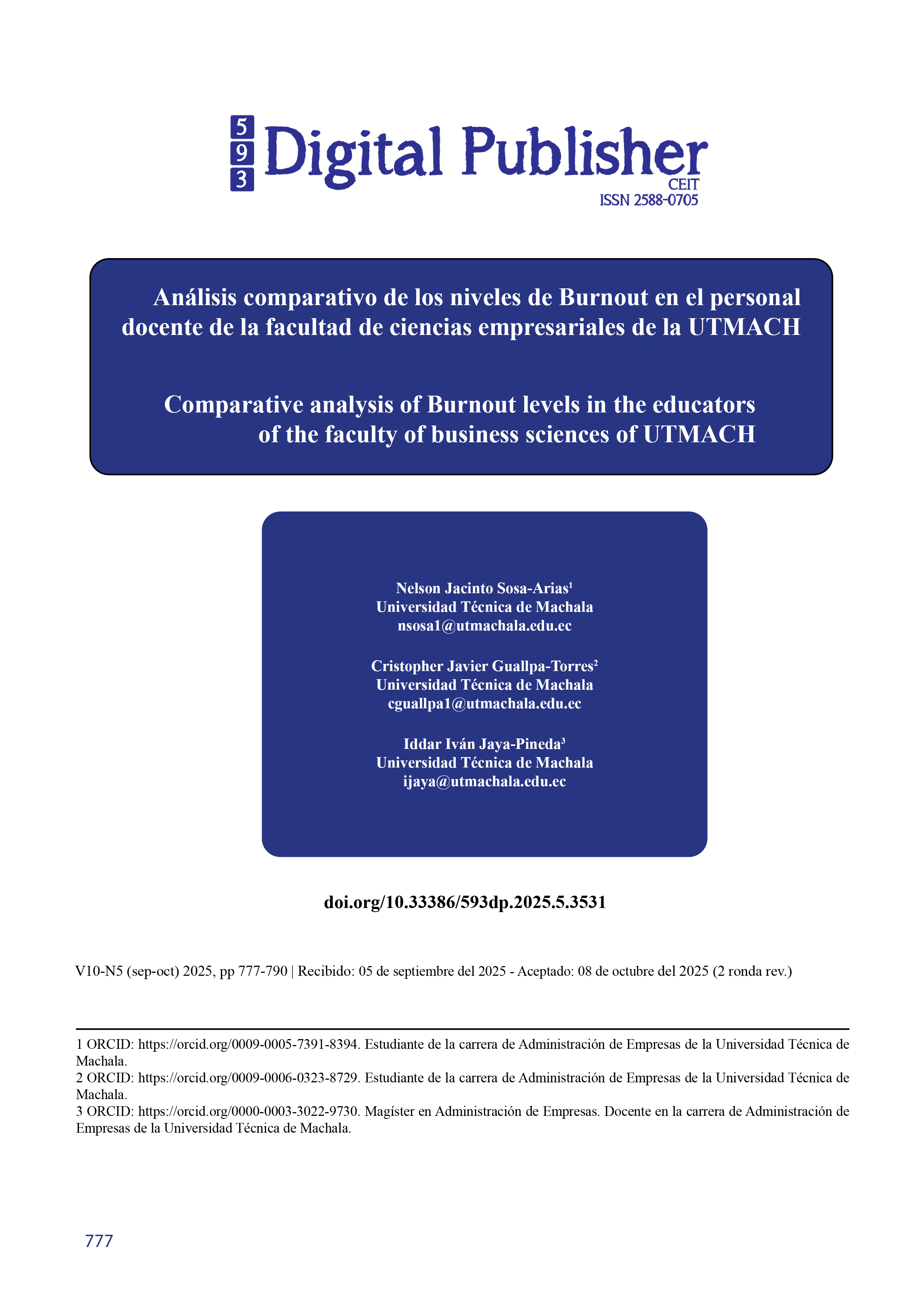Análisis comparativo de los niveles de Burnout en el personal docente de la facultad de ciencias empresariales de la UTMACH
Contenido principal del artículo
Resumen
Los estudios sobre burnout han crecido considerablemente debido a los cambios constantes del entorno y el impacto que este trastorno tiene sobre la salud pública. Sin embargo, los estudios locales son escasos demostrando una falta de interés por abordar esta problemática en Ecuador. Por consiguiente, esta investigación centra su atención en el personal docente de la Universidad Técnica de Machala (UTMACH). A partir del modelo de las demandas y recursos laborales y la evolución de la teoría del burnout desarrollada por Christina Maslach, se plantea como objetivo incidir en la gestión de riesgos psicosociales mediante el diagnóstico de la prevalencia de burnout en los docentes. Se desarrolla una investigación descriptiva con enfoque cuantitativo, de corte transversal y no experimental. La población de estudio la conformó un cuerpo colegiado de 101 docentes universitarios. Para el diagnóstico del burnout se aplicó el instrumento Maslach Burnout Inventory – Educator Survey (MBI – ES). Los principales hallazgos fueron una baja prevalencia de este trastorno con una alta presencia de agotamiento emocional en los hombres y de cinismo en las mujeres. Aunque otros estudios reportaron brechas tecnológicas a razón de la edad, en esta investigación se descartó la asociación con el burnout. En conclusión, el nivel de burnout en los docentes de la facultad de ciencias empresariales (FCE) de la UTMACH es bajo, pero se encuentra en una etapa decisiva que antecede a la agudización del mismo.
Descargas
Detalles del artículo

Esta obra está bajo una licencia internacional Creative Commons Atribución-NoComercial-CompartirIgual 4.0.
1. Derechos de autor
Las obras que se publican en 593 Digital Publisher CEIT están sujetas a los siguientes términos:
1.1. 593 Digital Publisher CEIT, conserva los derechos patrimoniales (copyright) de las obras publicadas, favorece y permite la reutilización de las mismas bajo la licencia Licencia Creative Commons 4.0 de Reconocimiento-NoComercial-CompartirIgual 4.0, por lo cual se pueden copiar, usar, difundir, transmitir y exponer públicamente, siempre que:
1.1.a. Se cite la autoría y fuente original de su publicación (revista, editorial, URL).
1.1.b. No se usen para fines comerciales u onerosos.
1.1.c. Se mencione la existencia y especificaciones de esta licencia de uso.
Citas
Anton, J. y Van Ryzin, M. (2024). Reducing teacher stress and burnout and enhancing self-efficacy through technology-supported small-group instruction. Social and Emotional Learning: Research, Practice, and Policy, 4, 1-8. https://doi.org/10.1016/j.sel.2024.100053
Bresó, E., Salanova, M., Schaufeli, W. y Nogareda, C. (2007). NTP 732: Síndrome de estar quemado por el trabajo “Burnout” (III): Instrumento de medición. Instituto Nacional de Seguridad e Higiene en el Trabajo. https://www.insst.es/documents/94886/327446/ntp_732.pdf/bf45e644-2986-42b0-b9a5-ce5bef2917bd
Chen, H., Song, W., Xie, J., Wang, H., Zheng, F. y Wen, Y. (2025). The Impact of Chinese Teachers’ Career Calling on Job Burnout: A Dual Path Model of Career Adaptability and Work Engagement. International Journal of Mental Health Promotion, 27(3), 379-400. https://doi.org/10.32604/ijmhp.2025.060370
Dilekçi, Ü., Kaya, A. y Çiçek, İ. (2025). Occupational stress, burnout, and change fatigue as predictors of quiet quitting among teachers. Acta Psychologica, 254, 1-7. https://doi.org/10.1016/j.actpsy.2025.104812
Dumitrescu, R. y de Caluwé, E. (2024). Individual differences in the impostor phenomenon and its relevance in higher education in terms of burnout, generalized anxiety, and fear of failure. Acta Psychologica, 249, 1-18. https://doi.org/10.1016/j.actpsy.2024.104445
Fitzsimons, S. y Smith, D. (2025). “Just plough on and pretend it’s not happening”: Understanding burnout in teacher educators in Ireland and the United Kingdom. International Journal of Educational Research Open, 9, 1-9. https://doi.org/10.1016/j.ijedro.2025.100491
Freudenberger, H. (1974). Staff bun-out. Journal of Social Issues, 30(1), 159-165.
Freudenberger, H. (1975). The staff burn-out syndrome in alternative institutions. Psychotherapy: Theory, Research, and Practice, 12(1), 73-82.
Golembiewski, R., Munzenrider, R. y Carter, D. (1983). Phases of Progressive Burnout and Their Work Site Covariants: Critical Issues in OD Research and Praxis. Journal of Applied Behavioral Science(13), 461-482. https://doi.org/10.1177/002188638301900408
Holmström, A., Tuominen, H., Laasanen, M. y Veermans, M. (2023). Teachers’ work engagement and burnout profiles: Associations with sense of efficacy and interprofessional collaboration in school. Teaching and Teacher Education, 132, 1-13. https://doi.org/10.1016/j.tate.2023.104251
Jones, F. y Fletcher, B. (2003). Job Control, Physical Health and Psychological Well-Being. En M. Schabracq, J. Winnubst, & C. Cooper, The Handbook of Work and Health Psychology (págs. 121-142). West Sussex: John Wiley & Sons, Ltd. https://www.al-edu.com/wp-content/uploads/2014/05/Handbook-of-Work-and-Health-Psychology-2Ed-2003.pdf
Leiter, M. y Maslach, C. (2016). Latent burnout profiles: A new approach to understanding the burnout experience. Burnout Research, 3(4), 89-100. https://doi.org/10.1016/j.burn.2016.09.001
Madigan, D., Kim, L., Glandorf, H. y Kavanagh, O. (2023). Teacher burnout and physical health: A systematic review. International Journal of Educational Research, 119, 1-12. https://doi.org/10.1016/j.ijer.2023.102173
Maslach, C. (1976). Burned-out. Human Behavior, 16-22.
Maslach, C. y Jackson, S. (1981). The measurement of experienced burnout. Journal of Occupational Behavior, 2, 99-113. https://doi.org/10.1002/job.4030020205
Maslach, C., Jackson, S. y Leiter, M. (1997). Maslach Burnout Inventory. En C. Zalaquett, & R. Wood, Evaluating Stress: A Book of Resources (págs. 191-218). Scarecrow Education. https://www.researchgate.net/profile/Christina-Maslach/publication/277816643_The_Maslach_Burnout_Inventory_Manual/links/5574dbd708aeb6d8c01946d7/The-Maslach-Burnout-Inventory-Manual.pdf
Maslach, C., Schaufeli, W. y Leiter, M. (2001). Job Burnout. Annual Review of Psychology, 52(1), 397-422. https://doi.org/10.1146/annurev.psych.52.1.397
Mora, C., Bonilla, G. y Bonilla, J. (2021). Impacto de la pandemia de covid-19 en los docentes: burnout, ansiedad y depresión. Revista Runae(6), 41-60. https://repositorio.unae.edu.ec/server/api/core/bitstreams/05c72735-c489-484b-ad17-882adb14b6fe/content
Moreno-Lucas, J., Martínez-Ramón, J., Morales-Rodríguez, F., Ruiz-Esteban, C. y Méndez, I. (2023). Stress, Burnout, and Resilience: Are Teachers at Risk? International Journal of Mental Health Promotion, 25(2), 207-222. https://doi.org/10.32604/ijmhp.2023.025901
Pagan-Garbín, I., Méndez, I. y Martínez-Ramón, J. (2024). Exploration of stress, burnout and technostress levels in teachers. Prediction of their resilience levels using an artificial neuronal network (ANN). Teaching and Teacher Education, 148, 1-11. https://doi.org/10.1016/j.tate.2024.104717
Peláez-Fernández, M., Mérida-López, S., Rey, L. y Extremera, N. (2022). Burnout, work engagement and life satisfaction among Spanish teachers: The unique contribution of core self-evaluations. Personality and Individual Differences, 196, 1-6. https://doi.org/10.1016/j.paid.2022.111727
Saltos-Bernal, G., Barbery-Montoya, D. y Ortega-Castro, J. (2023). Liderazgo transformacional y síndrome de burnout en el ámbito educativo: un estudio en la ESPOL. MQRInvestigar, 7(4), 1165-1187. https://doi.org/10.56048/MQR20225.7.4.2023.1165-1187
Schaufeli, W. y Bakker, A. (2004). Job demands, job resources, and their relationship with burnout and engagement: a multi-sample study. Journal of Organizational Behavior, 25, 293-315. https://doi.org/10.1002/job.248
Seisdedos, N. (1997). Inventario de burnout de Maslach. Madrid: TEA.
Szigeti, R., Balázs, N. y Urbán, R. (2023). Antecedents and components of burnout among Hungarian teachers in a cross-sectional study: Development of the Burnout Antecedents and Components Questionnaire. Acta Psychologica, 241, 1-12. https://doi.org/10.1016/j.actpsy.2023.104080
Toala, S. y Alpízar, J. (2021). Pandemia, desempeño docente y burnout en una unidad educativa. Revista Cognosis, 6(4), 189-202. https://doi.org/10.33936/cognosis.v6i4.3384
Torres-Hernández, E. y Lozano-Suárez, J. (2023). Burnout en docentes. Meta-análisis a partir del Maslach Burnout Inventory. Profesorado, Revista De Currículum Y Formación Del Profesorado, 27(3), 107-129. https://doi.org/10.30827/profesorado.v27i3.28052
Wang, Q., Gao, Y. y Wang, X. (2024). The Relationships Between Burnout, Job Satisfaction, and Emotion Regulation Among Foreign Language Teachers: A Meta-Analytic Review. Acta Psychologica, 250, 1-8. https://doi.org/10.1016/j.actpsy.2024.104545




